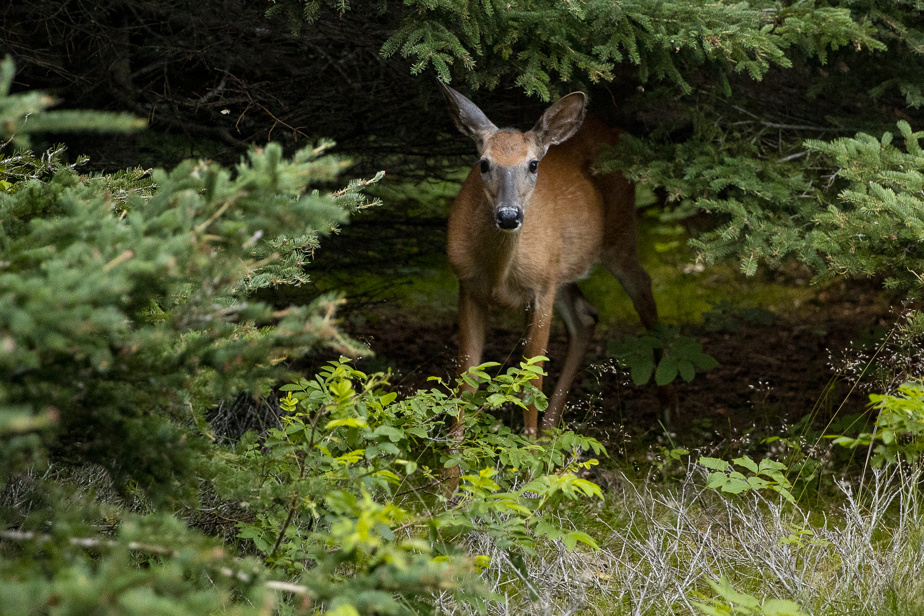No plant will be spared by a hungry deer

PHOTO FRANÇOIS ROY, LA PRESSE ARCHIVES
Widely used in Europe as a hedge, yews and their many cultivars are popular with deer. However, they have the advantage of growing back on grazed branches and produce pretty fruits that birds are fond of.
Experts are unanimous: no plant will be spared by a hungry deer. It’s a question of survival. But some species are much more popular than others. This is the case with thuja. “Cedar grows quickly, requires little maintenance and is inexpensive. It is the most popular conifer for erecting hedges, explains Marc Légaré, advisor to nursery growers for the Quebec Institute for the Development of Ornamental Horticulture. For deer, it is a prime food resource. » An observation confirmed by biologist Lisyanne Metthé who explains that, in its natural environment, the conifers most used by deer are thuja, yew and hemlock.
Furthermore, in certain regions, especially on Anticosti Island, and in many Christmas tree plantations, the balsam fir is also subject to significant browsing. On the other hand, the Japanese yew, the species often used in landscaping, has the advantage of growing back on bare branches. The catch: it grows slowly and it’s expensive.
From false cypress to white spruce

PHOTO ARMAND TROTTIER, LA PRESSE ARCHIVES
Pines, especially white pines like this “Taylor’s Sunburst” variety, are rarely popular with deer.
Rutgers University, a public establishment in the state of New Jersey, maintains a list of plants more or less coveted by white-tailed deer. In Quebec, Les jardin 2Montagnes also presents an interesting picture. At Rutgers, the long list of plants (trees, shrubs, perennials and annuals) is divided by categories, according to whether they are more or less appreciated by deer, but without taking into account their climatic resistance.
Among the least popular conifers are spruce (white, Norwegian, Colorado), several species and varieties of pine (white pine, pitch pine, red pine, Austrian black pine, Scots pine) and even false cypresses. (never damaged in the nursery, indicates Marc Légaré, as the plant gives off a particular smell when cut).
Deciduous trees and shrubs

PHOTO BERNARD BRAULT, LA PRESSE ARCHIVES
The leaves are a staple food for deer.
The leaves, twigs and buds of deciduous trees are the basis of the deer’s diet. The Rutgers directory presents four hardy species usually neglected by the animal. This is the case of the horse chestnut (the cultivars “Briotii” and “Fort McNair” produce red flowers and the buds are very sticky), the Katsura tree, the magnificent black birch and the paper birch. The other birches, the Saskatoon berry, and the twisted willow are also less attractive.

PHOTO ARMAND TROTTIER PRESS ARCHIVES
Several barberries or barberries reach 1.5 to 2 m in height, such as the “Rose Glow” variety with its magnificent foliage. Its branches full of thorns keep deer at bay.
The list of shrubs more or less neglected by deer is much longer. One of the most interesting species remains the barberry, notably the old cultivar “Rose Glow” with its 2 m height. Its foliage is very pretty. It is covered with thorns and can be made into an inextricable hedge. Other suggested species include boxwood, aralia, daphne, bohemian olive tree (exquisite fragrance), viburnums, elderberries, smoke tree, caryopteris, cinquefoil and several more or less varieties. creeping plants like microbiotas or junipers, two conifers.
Perennials and annuals

PHOTO ROBERT MAILLOUX, LA PRESSE ARCHIVES
Many perennials like these decorative alliums are of no interest to deer.
Deer love hostas, daylilies and perennial geraniums. Avoid if the garden is vulnerable. On the other hand, he is reluctant to eat the following perennials: aconite, agastache, decorative garlic, baptisia, brunera, coreopsis, bleeding heart, echinops, lavender, nepata, peony, perovskia, thalictrum, yucca. As for annuals, consider cleomes, calendula, heliotropes (very fragrant), helichrysums (immortelles), nicotines, matricarias or ageratums.
Repellent eggs
Years ago, when he was setting up his nursery, Jean-Pierre Devoyault tested a homemade repellent made from eggs. “It was an immediate success. The deer left our plants alone to graze on those of the neighbor,” explains the owner of Jardins de Jean-Pierre, in Sainte-Christine, a corner of the South Shore where the density of deer is considerable.
Recently, the University of Minnesota, an institution renowned for its research in horticulture, cited a survey of deer repellents which concluded that one of the most effective concoctions was simply a solution of fresh whole eggs mixed with water that is sprayed on plants: 3 eggs per 3.7 liters of water. A potion similar to that of Mr. Devoyault. Even though there are a host of variations, there is no need to add other ingredients, argues the University. The treatment is odorless for humans, but must be renewed every 15 days and is inactive in winter, according to the establishment.
Check out the Rutgers University list
Visit the University of Minnesota page
Consult the list of the Jardin2M nursery
